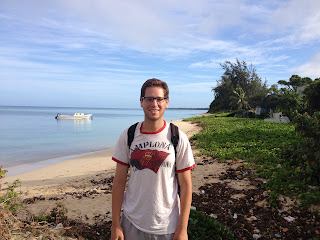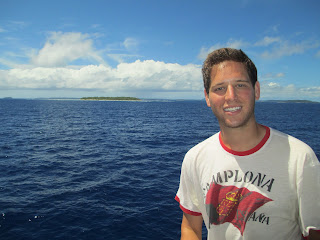Judging from the randomness of the
title of this blog post, my readers may be asking themselves what any of these
subjects can possibly have in common. The answer, without any facetiousness on
my part, is nothing.
Since no singular event occurred in
my life in the past week, and I have no great theme which I would like to
introduce at this time I have decided to briefly relate small anecdotes on each
of the subjects alluded to above.
Termites
Frequent readers will notice that the
tone of this blog is fairly positive. That is because, with few exceptions, my
experience as a Peace Corps Volunteer in Tonga has been overwhelmingly
positive. One of these exceptions, however, is rather miniscule yet has become
quite a nuisance.
For the past two months I have been
waging a silent war – silent in the fact that I had not previously mentioned
the subject in this blog but quite loud within the confines of my home – against
termites. To be fair they might not be termites, but carpenter ants or some
other nameless sub-species. I am by no means an expert concerning insects, but
since these ants leave wood fillings around my house I have taken to calling
them termites.
My methods of extermination and
co-habitation have been numerous. I have filled up the holes in my house, as a
way of preventing the continuous onslaught of these invaders by such measures
as silly putty, duct tape, scotch tape, and strips of cardboard from the
packages I have received. I have sprayed an overwhelming amount of mortein –
the bug spray used in Tonga – that is undoubtedly bad for my health but
necessary of my very survival. I have even resorted to the Tongan remedy, as
related to me by the town officer of my village Havea, of placing kerosene in
the cracks of my house to discourage the alien intruders.
So far I have met with mixed results.
Due to my constant vigilance, the termites have temporarily retreated, but
since I believe this retreat was purely tactical and thus temporary, I am
planning on splitting the cost of an expensive (for Tonga and my stipend)
termite jell with another volunteer who shares my problems.
For those of you back home, please
don’t be grossed out or feel bad for me as I consider myself very lucky. Other
volunteers have major issues with rats and cockroaches – problems far greater
than my own – and I am quite content that I only have to battle these pesky
insects that somewhat helpfully fill up my free time.
Christmas
As Tonga is a very religious and
Christian country, Christmas is very important here. Christmas in Tonga has a
very different feeling from America, however, as there is much less of an
emphasis on gift giving, and more of a focus on church and community.
Christmas Eve is exclusively a youth
event in Tonga, or at least in my village. All of the youth performed songs and
dances in front of the village elders and some of the parents. After these
performances the little kids were given a few presents while the teenagers and
older kids were given bags of candy. Wanting to take part in the gift giving, I
gave some of the kids glow in the dark glow sticks (thank you Mary Sue!) I had
received in a package and must have seemed like magic to the kids. In return I
was rewarded with bags of every candy I have seen in Tonga (no where near as
much as in America, but substantial in its own right) that I have been
thankfully munching on the past few days.
The next days, Christmas, was very
much like any Sunday in Tonga. Church starts at the same time – 10 a.m. – and
lasts until 11:30 a.m. as always. The difference however is that after church
the entire village ate a massive feast in the hall next door. I was given the
honor of sitting in the front with the village elders and church ministers,
where we were allotted the best food and greatest portions of meet.
Over the next two hours, everyone
feasted and the adults took turns standing up and issuing fakamalo, which
literally translate to the saying of thanks. Though I could not understand much
of what was said, I was mentioned frequently and was continuously humbled by
how thankful they all were for my being there even though I have yet to start
teaching.
It was a very nice and Tongan affair,
and like all Tongan feasts, I was gifted with as many left over’s as I could
carry and that happily sustained me for several days after.
Feasts
On the subjects of feasts, my theory
is that Tongans just look for any and every excuse to hold a feast. Events, no
matter how big or how small, are not truly honored without a kaipola, or feast.
In the past month alone, I have attended
a feast for the annual fundraiser, the youth group (of which I am considered a
part of and consists of everyone in the village from the ages of roughly 3 to
anyone who is not yet married), a wedding, and of course Christmas. I love the feasts,
as it is the only time, besides church, when the entire community comes together
and are always very festive occasions.
Planning
Last but not least, to assure all of
my readers that I am not just sitting around my house all day doing nothing and
feasting – that consists of only half my day – I have been busy planning this
past week for the upcoming term. I still have a long way to go, but my goal is
to plan out the entire first term (ten weeks) for all of my English classes for
Classes 6, 5, 4, and 3.
I have no clue what I am doing and
all of this may be a waste of time as I sadly learned that my principle Sione
has been reassigned and that I will have a new principle when school starts and
whom might change my schedule. That being said, I am trying to make the most of
my time and I hope this planning will make my entry to the classroom much
smoother.
To conclude, I apologize for the
absence of photos in the past few posts. I, unfortunately, have no new photos
of myself as there is no one to take them and the café where I usually post
these updates is temporarily closed and the Internet of the current
establishment I am in does not have good enough Internet for me to upload
photos. I promise, however, to remedy this soon.
Happy New Year!


















